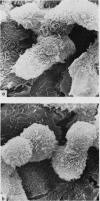Abstract
The effects of short chain fatty acids on a colon carcinoma cell line, LIM1215, have been studied. Of the four short chain fatty acids tested only butyrate at 1 mmol/l and 10 mmol/l and acetate at 10 mmol/l had significant effects on this cell line. The addition of butyrate to growth medium affected the growth rate and the production of alkaline phosphatase, dipeptidyl peptidase IV and carcinoembryonic antigen. Butyrate at a final concentration of 1 mmol/l increased the doubling time of the cells from 26 hours to 72 hours and decreased the cloning efficiency of the cells from 1.1% to 0.054%. Alkaline phosphatase concentrations increased rapidly in cells cultured in 1 mmol/l butyrate reaching peak levels after four days with alkaline phosphatase concentrations increasing more than six-fold. Levels of dipeptidyl peptidase IV and carcinoembryonic antigen were also increased after culture in butyrate containing medium. The number of alkaline phosphatase containing and dipeptidyl peptidase IV containing cells increased markedly in butyrate containing cultures. In contrast the number of mucus containing cells decreased in cultures grown in medium containing butyrate. This differentiating effect of butyrate on colon carcinoma cells may be relevant to the presence of butyrate in the colonic contents and the relationship between short chain fatty acids and fibre intake.
Full text
PDF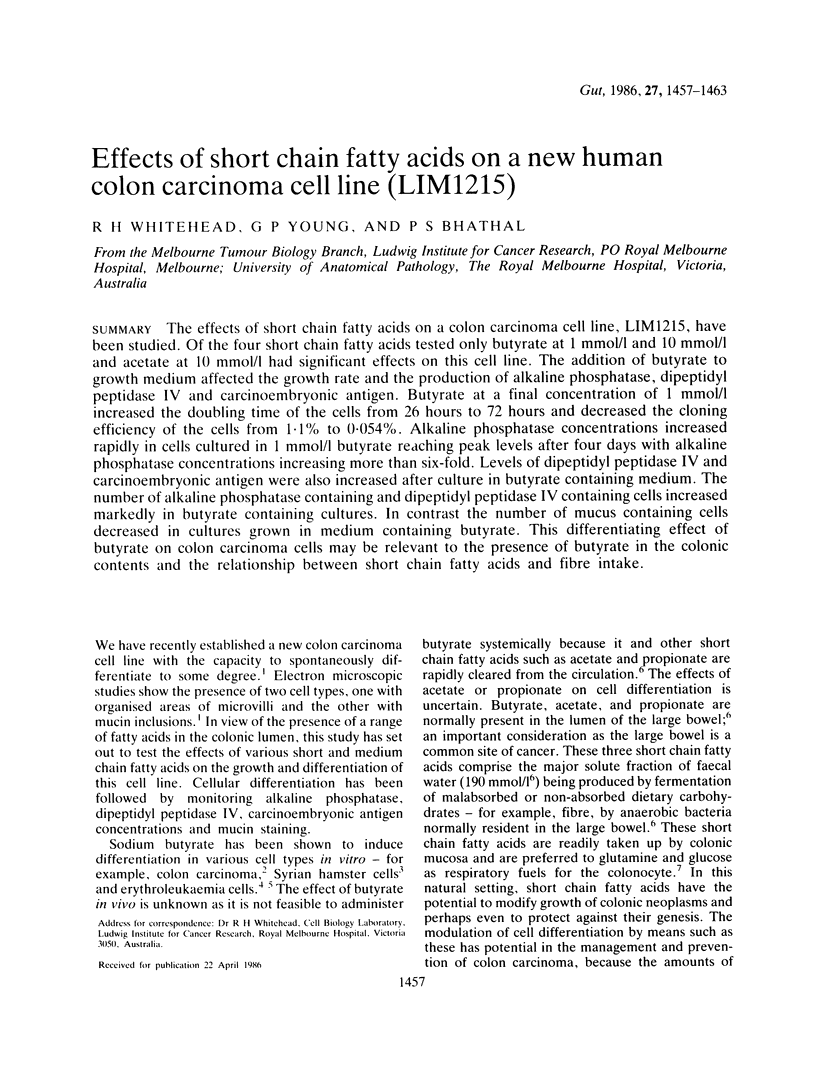
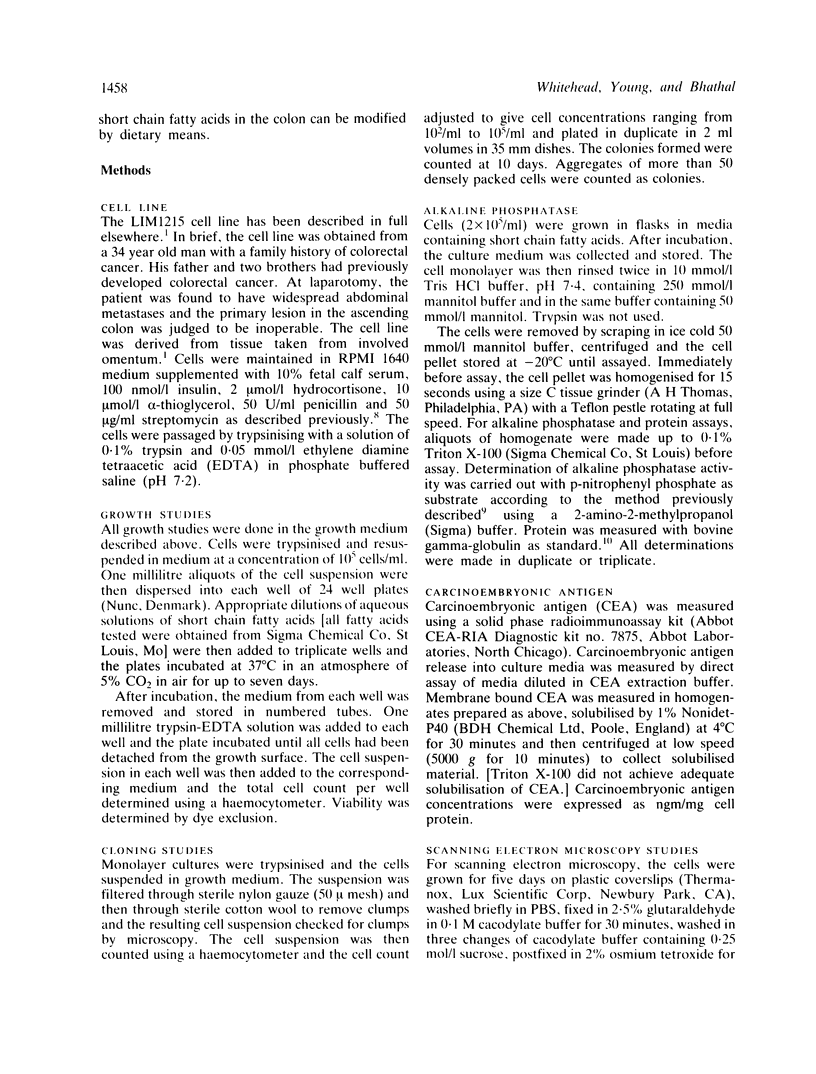
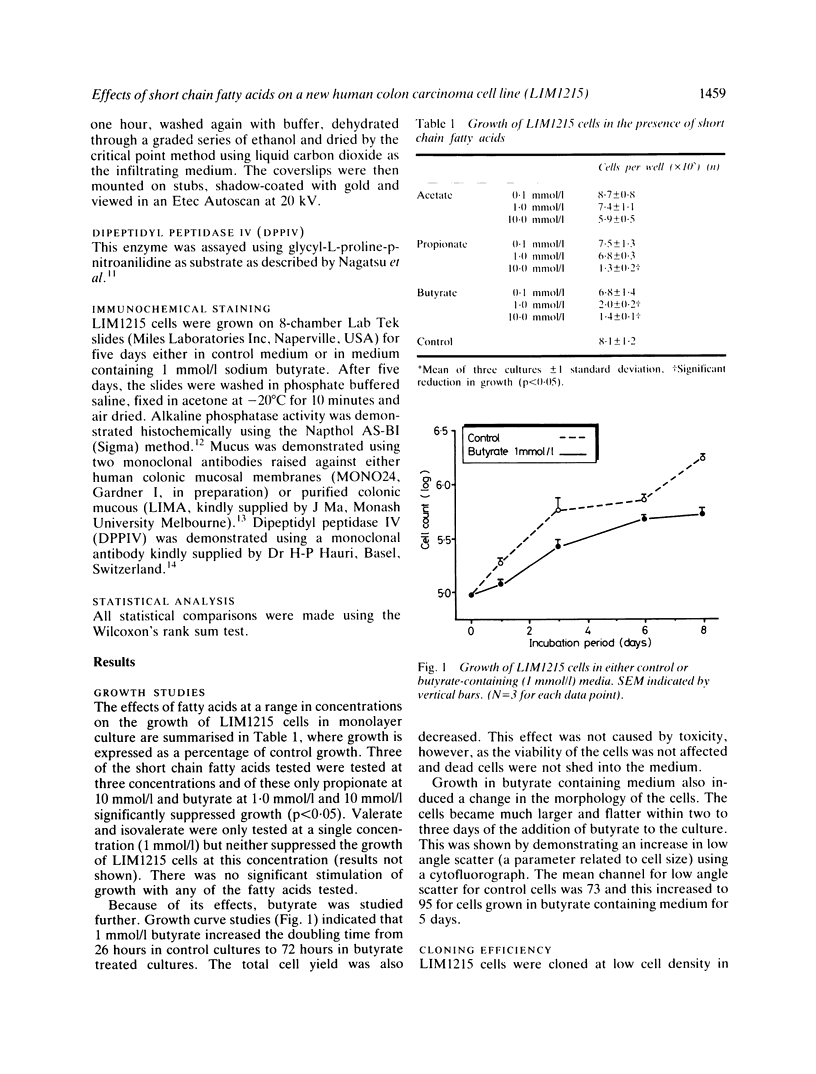

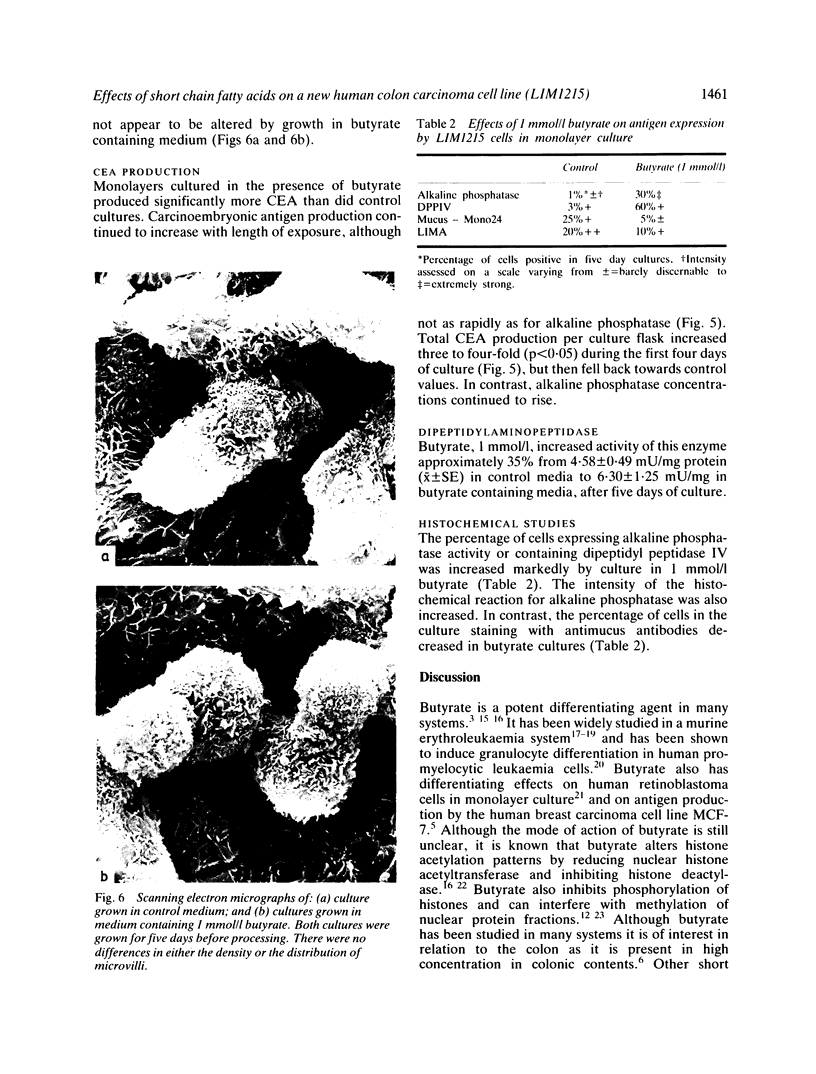
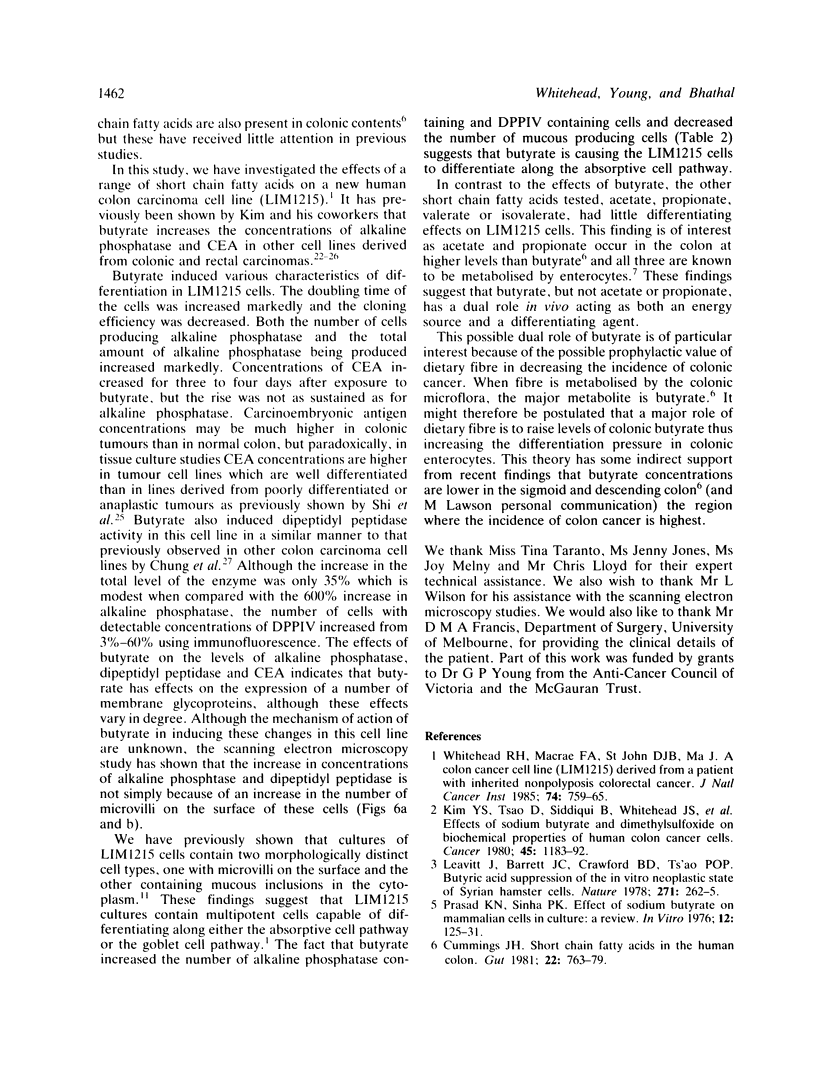
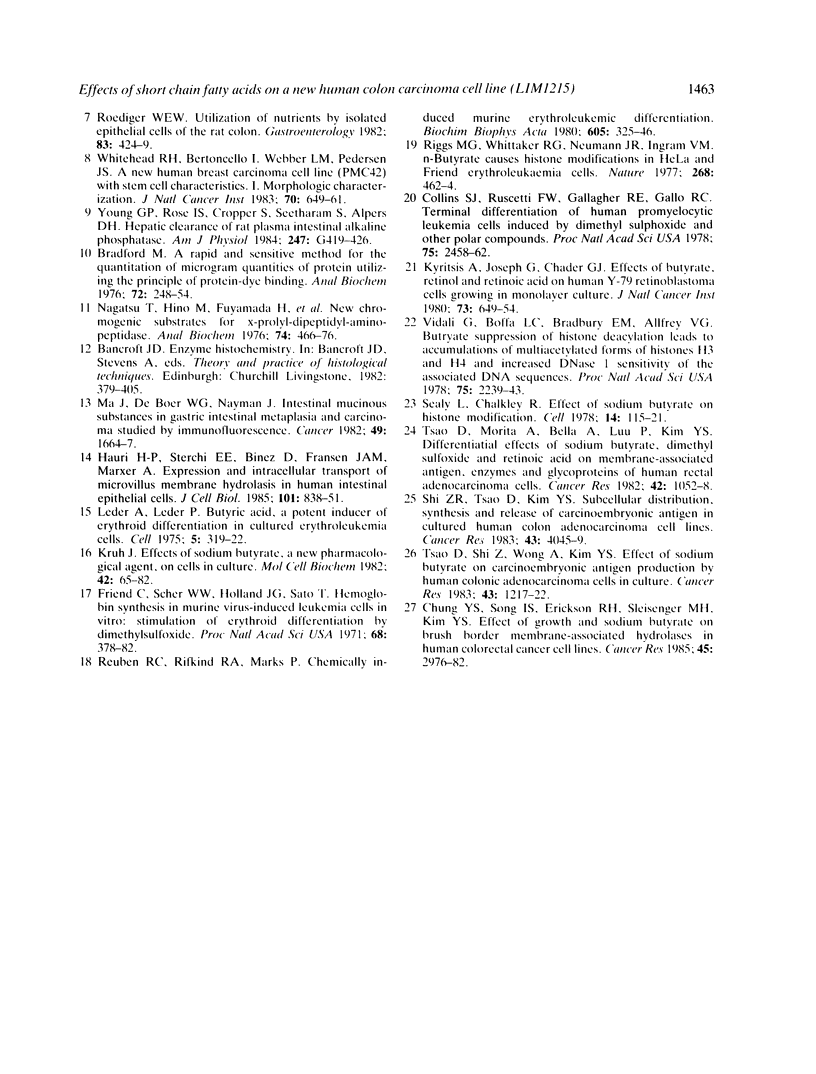
Images in this article
Selected References
These references are in PubMed. This may not be the complete list of references from this article.
- Bradford M. M. A rapid and sensitive method for the quantitation of microgram quantities of protein utilizing the principle of protein-dye binding. Anal Biochem. 1976 May 7;72:248–254. doi: 10.1006/abio.1976.9999. [DOI] [PubMed] [Google Scholar]
- Chung Y. S., Song I. S., Erickson R. H., Sleisenger M. H., Kim Y. S. Effect of growth and sodium butyrate on brush border membrane-associated hydrolases in human colorectal cancer cell lines. Cancer Res. 1985 Jul;45(7):2976–2982. [PubMed] [Google Scholar]
- Collins S. J., Ruscetti F. W., Gallagher R. E., Gallo R. C. Terminal differentiation of human promyelocytic leukemia cells induced by dimethyl sulfoxide and other polar compounds. Proc Natl Acad Sci U S A. 1978 May;75(5):2458–2462. doi: 10.1073/pnas.75.5.2458. [DOI] [PMC free article] [PubMed] [Google Scholar]
- Cummings J. H. Short chain fatty acids in the human colon. Gut. 1981 Sep;22(9):763–779. doi: 10.1136/gut.22.9.763. [DOI] [PMC free article] [PubMed] [Google Scholar]
- Friend C., Scher W., Holland J. G., Sato T. Hemoglobin synthesis in murine virus-induced leukemic cells in vitro: stimulation of erythroid differentiation by dimethyl sulfoxide. Proc Natl Acad Sci U S A. 1971 Feb;68(2):378–382. doi: 10.1073/pnas.68.2.378. [DOI] [PMC free article] [PubMed] [Google Scholar]
- Hauri H. P., Sterchi E. E., Bienz D., Fransen J. A., Marxer A. Expression and intracellular transport of microvillus membrane hydrolases in human intestinal epithelial cells. J Cell Biol. 1985 Sep;101(3):838–851. doi: 10.1083/jcb.101.3.838. [DOI] [PMC free article] [PubMed] [Google Scholar]
- Kruh J. Effects of sodium butyrate, a new pharmacological agent, on cells in culture. Mol Cell Biochem. 1982 Feb 5;42(2):65–82. doi: 10.1007/BF00222695. [DOI] [PubMed] [Google Scholar]
- Leavitt J., Barrett J. C., Crawford B. D., Ts'o P. O. Butyric acid suppression of the in vitro neoplastic state of Syrian hamster cells. Nature. 1978 Jan 19;271(5642):262–265. doi: 10.1038/271262a0. [DOI] [PubMed] [Google Scholar]
- Leder A., Leder P. Butyric acid, a potent inducer of erythroid differentiation in cultured erythroleukemic cells. Cell. 1975 Jul;5(3):319–322. doi: 10.1016/0092-8674(75)90107-5. [DOI] [PubMed] [Google Scholar]
- Ma J., De Boer W. G., Nayman J. Intestinal mucinous substances in gastric intestinal metaplasia and carcinoma studied by immunofluorescence. Cancer. 1982 Apr 15;49(8):1664–1667. doi: 10.1002/1097-0142(19820415)49:8<1664::aid-cncr2820490822>3.0.co;2-o. [DOI] [PubMed] [Google Scholar]
- Prasad K. N., Sinha P. K. Effect of sodium butyrate on mammalian cells in culture: a review. In Vitro. 1976 Feb;12(2):125–132. doi: 10.1007/BF02796360. [DOI] [PubMed] [Google Scholar]
- Reuben R. C., Rifkind R. A., Marks P. A. Chemically induced murine erythroleukemic differentiation. Biochim Biophys Acta. 1980 Sep 22;605(3):325–346. doi: 10.1016/0304-419x(80)90015-3. [DOI] [PubMed] [Google Scholar]
- Roediger W. E. Utilization of nutrients by isolated epithelial cells of the rat colon. Gastroenterology. 1982 Aug;83(2):424–429. [PubMed] [Google Scholar]
- Sealy L., Chalkley R. The effect of sodium butyrate on histone modification. Cell. 1978 May;14(1):115–121. doi: 10.1016/0092-8674(78)90306-9. [DOI] [PubMed] [Google Scholar]
- Shi Z. R., Tsao D., Kim Y. S. Subcellular distribution, synthesis, and release of carcinoembryonic antigen in cultured human colon adenocarcinoma cell lines. Cancer Res. 1983 Sep;43(9):4045–4049. [PubMed] [Google Scholar]
- Tsao D., Shi Z. R., Wong A., Kim Y. S. Effect of sodium butyrate on carcinoembryonic antigen production by human colonic adenocarcinoma cells in culture. Cancer Res. 1983 Mar;43(3):1217–1222. [PubMed] [Google Scholar]
- Whitehead R. H., Bertoncello I., Webber L. M., Pedersen J. S. A new human breast carcinoma cell line (PMC42) with stem cell characteristics. I. Morphologic characterization. J Natl Cancer Inst. 1983 Apr;70(4):649–661. [PubMed] [Google Scholar]
- Whitehead R. H., Macrae F. A., St John D. J., Ma J. A colon cancer cell line (LIM1215) derived from a patient with inherited nonpolyposis colorectal cancer. J Natl Cancer Inst. 1985 Apr;74(4):759–765. [PubMed] [Google Scholar]
- Young G. P., Rose I. S., Cropper S., Seetharam S., Alpers D. H. Hepatic clearance of rat plasma intestinal alkaline phosphatase. Am J Physiol. 1984 Oct;247(4 Pt 1):G419–G426. doi: 10.1152/ajpgi.1984.247.4.G419. [DOI] [PubMed] [Google Scholar]



